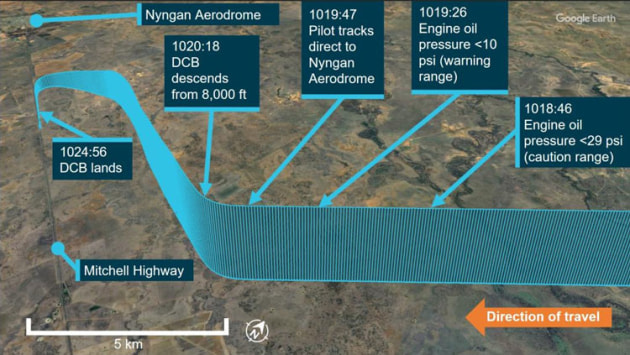A Cirrus pilot faced with an engine failure executed a forced landing on a highway rather than fire off the airframe parachute, drawing praise last week from the ATSB.
SR22 VH-DCB was on a flight from Gold Coast to Mildura in January this year with the pilot and one passenger on board when the engine lost oil pressure north-west of Dubbo. After the pilot declared a PAN and diverted for landing at Nyngan, the pilot heard a loud bang and saw flames coming from the engine.
After declaring a MAYDAY, the pilot elected to land the aircraft on the Mitchell Highway rather than activate the Cirrus Airframe Parachute System (CAPS) over concerns the pregnant passenger could be harmed when the aircraft impacted the ground.
The pilot dived the Cirrus to successfully extinguish the fire, but smoke began entering the cockpit. The pilot managed to avoid traffic landing on the highway and no-one was injured, and only minor further damage done to the aeroplane.
On inspection, the pilot found the crankcase had ruptured near the number 6 cylinder, with a connecting rod separating from the crankshaft.
“The pilot’s timely and effective decision-making, likely supported by their experience on the aircraft type and knowledge of its performance capabilities, mitigated the risk of injury and further damage to the aircraft,” ATSB Director Transport Safety Dr Stuart Godley said.
“This incident demonstrates how the ‘aviate, navigate, communicate’ framework establishes a clear hierarchy of priorities, particularly during emergencies.
“Acting in the appropriate order of priority improves situational awareness and supports coordinated responses in a dynamic environment.”
ATSB investigators were unable to determine the reason for the initial loss of oil pressure, which led to the catastrophic failure because the engine had not been stripped down when the investigation was concluded.
“Although engine failures are relatively rare, they do happen,” Godley pointed out. “Given the potential severity of the consequences of an engine failure or power loss in a single‑engine aircraft, such occurrences therefore need to be planned for and managed appropriately.”
The full report is on the ATSB website.



